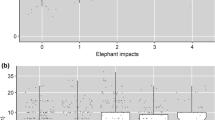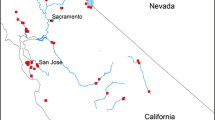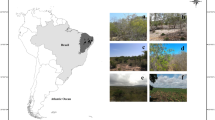Abstract
African elephants and other indigenous megaherbivores have a major impact on local vegetation structure, including aquatic communities, as their big feet and large mass pound the fringes of water bodies. This disturbance is likely to have a profound influence on the structure and composition of insect assemblages in these habitats. We investigated which dragonfly (Odonata) species were tolerant of trampling by elephants and other game. Assemblage composition differed according to extremely high, very high or high disturbance levels. Dragonfly abundance was greatest where impact was high, and decreasing when disturbance became very high or extremely high. Several odonate species are well-adapted to fairly high levels of disturbance, although too much is impoverishing. Medium and low impact sites were geographically separated, and this, combined with much lower disturbance levels, had a considerable influence on promoting regional dragonfly diversity. Several regional specialist species only occurred in the geographically separated, low-impact sites. The full complement of dragonflies is present only when there is a combination of various disturbance levels combined with spatial variation. Elephant impact is similar to that of humans, with too much of either or both, leading to a species-poor, habitat-generalist dragonfly assemblage.




Similar content being viewed by others

References
Ben-Shahar R (1993) Patterns of elephant damage to vegetation in northern Botswana. Biol Conserv 65:249–256
Botes A, McGeoch MA, van Rensburg BJ (2006) Elephant- and human-induced changes to dung beetle (Coleoptera: Scarabaeidae) assemblages in the Maputaland Centre of Endemism. Biol Conserv 130:573–583
Buechner HK, Dawkins HC (1961) Vegetation change induced by elephants and fire in Murchison Falls National Park. Ecology 42:752–766
Cumming DHM, Fenton MB, Rautenbach IL, Taylor RD, Cumming GS, Cumming MS, Dunlop JM, Ford AG, Hovorka MD, Johnston DS, Kalcounis M, Mahlangu Z, Portfors CVR (1997) Elephants, woodlands and biodiversity in southern Africa. South Afr J Sci 93:231–236
Dijkstra K-DB (2006) African Diplacodes: the status of the small species and the genus Philonomon (Odonata: Libellulidae). Int J Odonatol 9:119–132
Dublin H, Sinclair A, McGlade J (1990) Elephants and fire as causes of multiple stable states in the Serengeti-Mara woodlands. J Anim Ecol 59:1147–1164
Fahrig L (2003) Effects of habitat fragmentation on biodiversity. Ann Rev Ecol Syst 34:487–515
Gibson L (2004) Evidence of hierarchical patch dynamics in an East African savanna? Landscape Ecol 19:883–894
Laws RM (1970) Elephants as agents of habitat and landscape change in East Africa. Oikos 21:1–15
Leps J, Šmilauer, P (2003) Multivariate Analysis of Ecological Data Using CANOCO. Cambridge University Press, Cambridge
Lombard AT, Johnson CF, Cowling RM, Pressey RL (2001) Protecting plants from elephants: botanical reserve scenarios within the Addo Elephant National Park, South Africa. Biol Conserv 102:191–203
Rivers-Moore NA, Samways MJ (1996) Game and cattle trampling, and impact of human dwellings on arthropods at a game park boundary. Biodivers Conserv 5:1545–1556
Samways MJ, Kreuzinger K (2001) Vegetation, ungulate and grasshopper interactions inside vs. outside an African savanna game park. Biodivers Conserv 10:1963–1981
Samways MJ, Steytler NS (1996) Dragonfly (Odonata) distribution patterns in urban and forest landscapes and recommendations for riparian corridor management. Biol Conserv 78:279–288
Statsoft Inc. (2003) STATISTICA (Data analysis software system) Statsoft Inc. Tulsa, USA (Software package)
Suhling F, Sahlén G, Martens A, Marais E, Carsten S (2006) Dragonfly assemblages in arid tropical environments: a case study from western Namibia. Biodivers Conserv 15:311–332
ter Braak CJF, Šmilauer P (2003) CANOCO Reference Manual and Users’Guide to CANOCO for Windows: Software for Canonical Community Ordination (Version 4). Microcomputer Power, Ithaca, New York
Van de Vijver CADM, Foley CA, Olff H (1999) Changes in the woody component of an East African savanna during 25 years. J Trop Ecol 15:545–564
Vera FWM (2000) Grazing ecology and forest history. CABI Publishing, Oxon, UK
Western D, Maitumo D (2004) Woodland loss and restoration in a savanna park: a 20–year experiment. Afr J Ecol 42:111–121
Acknowledgements
We thank Russel Friedman of Wilderness Safaris for making this study possible, and Marlon Samways for practical support.
Author information
Authors and Affiliations
Corresponding author
Rights and permissions
About this article
Cite this article
Samways, M.J., Grant, P.B.C. Elephant impact on dragonflies. J Insect Conserv 12, 493–498 (2008). https://doi.org/10.1007/s10841-007-9089-2
Received:
Accepted:
Published:
Issue Date:
DOI: https://doi.org/10.1007/s10841-007-9089-2



